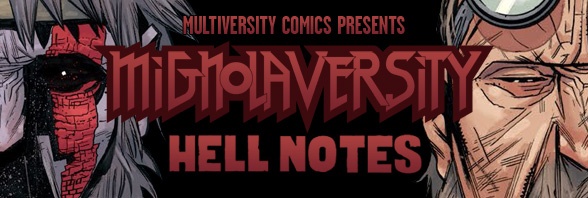
It’s the last Hell Notes of the year, and with Ted Howards taking a more prominent role in the latest arc of B.P.R.D. Hell on Earth, I figured I’d shine a light on him and his ancient counterpart, Gall Dennar. That, and all the various elements that sprout out from this period of time.
Spoiler Warning. It’s probably a good idea to have read up to the latest issue of B.P.R.D. Hell on Earth and at least issue 14 of Abe Sapien.
THE ABYSS OF TIME

At the time it came out, this two-issue story seemed like an interesting side adventure. Some may have thought it inconsequential to the series’ narrative, but this was a story tied to so many elements of the broader Mignolaverse mythology, I knew a major piece had just been put into play.

In 1991, Hellboy and Agent Pauline Raskin were sent to investigate a haunted house that had once belonged to a Dr. Carp, a Grand Master in the Golden Lodge of the Heliopic Brotherhood of Ra. Hellboy was sent into a secret room they’d discovered, but as he stepped through the door he was transported back in time to 1902, where he met Dr. Carp in the flesh. When Hellboy returned back to 1991, he discovered he’d been gone for only a second or two at the most, and no one even knew he’d gone.2
I mention all this because Agent Howards was about to have a somewhat similar experience. While looking at a bunch of artefacts in a display case, he reached out and touched a strange-looking sword, then immediately passed out.


Howards awoke under an unfamiliar sky, with a bleeding head wound. He was surrounded by people he didn’t know, dressed in tribal garb, and having his wound tended to by a shaman called Dar San Dar. They kept calling him Gall Dennar, and as Howards looked down at his body, he saw that it was not his own, but that of a man like the people that surrounded him. They believed his head wound was causing his confusion.
Apparently he had been in a battle, and his father, Gall Haddat, had been slain. Gall Dennar had rushed to his father’s side and taken up his weapon, but as soon as he touched it, he had passed out. They had been fighting the cold people, an evil breed that would rise from their graves if a wooden stake was not hammered through their heart.3
As Howards listened to Dar San Dar speak, memories stirred in him from when he was a child being taught to throw a spear by his father, Gall Haddat. He had begun to remember a life he had never lived as if it was his own.
That evening, Gall Dennar questioned Dar San Dar about his sword. Where did it come from? Dar San Dar, though he knew Gall Dennar should know the tale as well as himself, explained how Gall Dennar’s grandfather had come across it in the ruins of an enormous village made of stone, the home of a long gone ancient people (the Hyperboreans). Among the ruins he found the corpse of a warrior, surrounded by the inhuman bodies of his enemies, his sword broken off at the hilt. The blade of the weapon, though very old, was still sharp, and so Gall Dennar’s grandfather fashioned for it a new handle and took it for his own. When night fell, the ghosts of the inhuman creatures he had seen by the warrior came for him, but the spirit of the ancient warrior entered his arm and fought back the creatures.
Continued below
Gall Dennar also told Dar San Dar a tale of his own, of a dream he had had of a world overrun with monsters far worse than the cold people, though I wonder if he really thought it was a dream. Perhaps he fully retained his memories as Ted Howards and was simplifying matters for the shaman. Dar San Dar told Gall Dennar how long ago great shaman warriors had fought against monsters. He thought that perhaps Gall Dennar’s sword retained the memory of those days. Dar San Dar feared that the cold people were the children of those monsters, and that if they were not stopped, perhaps they would raise their parents from their graves too.
Maybe Gall Dennar believed part of what Dar San Dar had said, that the blade had retained memories of the past and perhaps he thought that was what he was experiencing. Perhaps he was completely aware he was really Ted Howards and thought that he could change the past. I don’t know. But by morning, he had decided to lead his warriors into the cold people’s valley and hunt the foul creatures down, even though several of his tribe did not think it necessary.
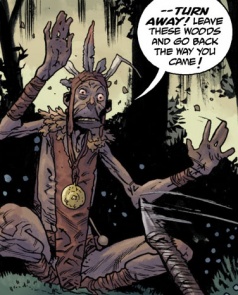
Deep in the territory of the cold people, Gall Dennar found a stone structure. In its centre was a statue of the Black Goddess, Heccatta,4 with a priest of the cold people worshiping at its foot. The priest called this place the last temple of the gods and bid them to pay homage, for the masters of the world, the Ogdru Jahad, would come again. And, of course, then the cold people attacked.
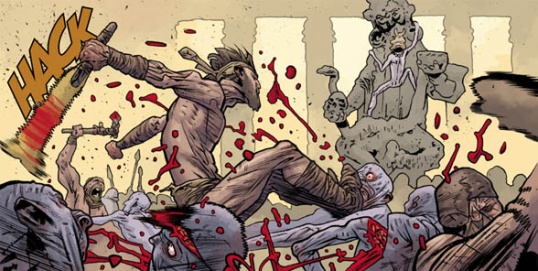
As blood was spilt in battle, the Ogdru Hem spirit gained strength and began to weave a body for itself. Gall Dennar could not hope to defeat such a creature, but it seemed it was drawing its strength from elsewhere, so Gall Dennar killed the priest instead, and the creature was gone.
Meanwhile, back in present day Chicago, Lehane and Grafton were trying to wake the unconscious Howards when an old man entered the room, the symbol of the Heliopic Brotherhood of Ra hung around his neck. The man pulled a gun, shot Lehane, then turned on Grafton. He and Grafton fired at the same time and both were killed.
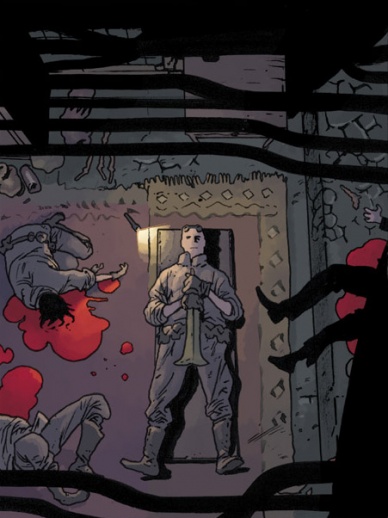
HOWARDS’ AWAKENING
When no word had come back from Lehane’s team, a second, larger Bureau team was sent to Chicago, heavily armed. Good thing too, because on the way things went horribly wrong, and by the time they arrived on site they had a whole lot of mutants on their tail. Howards had been asleep about three or four days at this point, yet he was still alive, and apart from being asleep, seemed in good health. Before they could check on him further, the Bureau team was attacked by the pursuing mutants. In the chaos, the sword in Howards’ hand was bumped and he awoke. When he saw the mutants, he went on a murderous rampage.

This was a horde of mutants that a B.P.R.D. team with machine guns couldn’t hold back, but with Howards unleashed, he slaughtered them all single-handedly without so much as a scratch. And the red gas that had transformed the locals into the mutants in the first place had no effect on him either. This wasn’t just a really good warrior with a cool sword. The sword had made him something more.
Continued below
Three months later Howards wasn’t settling in any better. He was still ignoring Gervesh and pretty much everyone else on base, he didn’t speak, and he carried his sword around with him everywhere. However, he was good in a fight and so everyone wanted him on their team.
I think the nature of Howards and Gall Dennar’s connection is a little more complicated than a simple swap of personalities though. In B.P.R.D. Hell on Earth: Lake of Fire there was a sequence that teased something more…
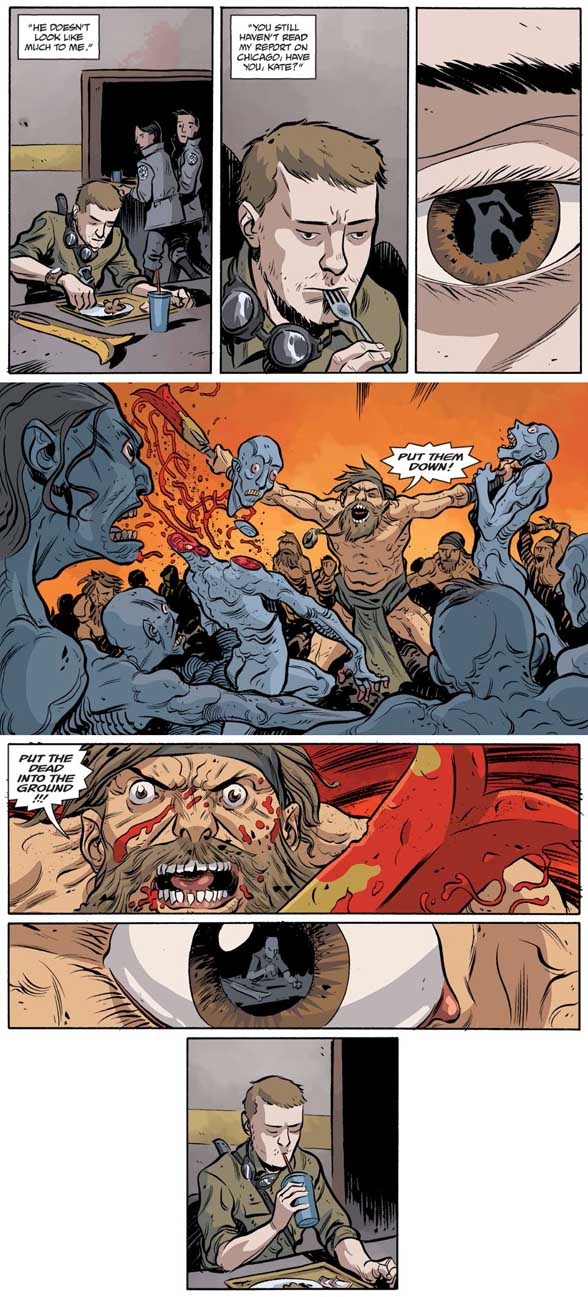
It seems to me Gall Dennar and Ted Howards are still aware of the life the other is living. Gall Dennar, in Howards’ body in the present, has the memory of fighting the cold people with his father’s sword in hand, even though that’s something he never did. And likewise, Howards, in Gall Dennar’s body in the past, has the memory of sitting alone in the B.P.R.D. cafeteria with a Hyperborean sword by his dinner tray, something the old Howards never did.
When did this start happening? Perhaps when Howards originally awoke in Gall Dennar’s body he was only himself, aware of no other connection, but three or four days later, the connection became apparent as Gall Dennar in Howards’ body awoke in Chicago and finely diced a small army of mutants. It’s even possible they are aware of the other’s mind on some level, not just their memories.
However it works, this opens up some interesting possibilities. Gall Dennar and Howards can use the information from their memories of this other life. It’s a link that could prove very useful, and if developed, maybe even become something more. Perhaps if we look closer at the sword we may discover something…
THE HYPERBOREAN SWORD

But in B.P.R.D.: Hollow Earth we encountered another kind of sword, wielded by the King of Fear. This weapon could channel and harness Vril energy drained from Liz Sherman. And if you take a look at the handle on it, this weapon is very different from the other Hyperborean swords.

Of course, Gall Dennar’s weapon doesn’t have its original handle; it has one fashioned by his grandfather. But we have seen a glimpse of it, and it is quite clear this blade is a weapon just like the one used by the King of Fear. Which means this weapon is capable of harnessing Vril.
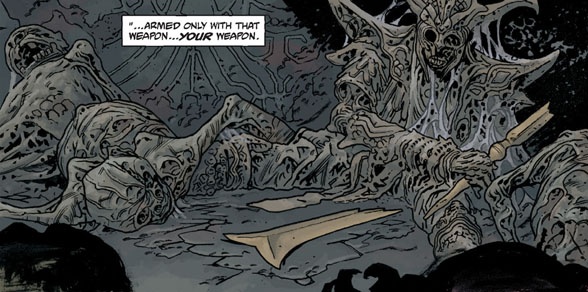
In case you aren’t already familiar with the term (I tend to use it a lot in these columns), Vril energy is the Fire of Heaven. I suppose you could call it the power of god. It is woven into the very foundations of the Hellboy universe, from the creation of the world, the Ogdru Jahad, the watchers, the Hyperboreans, even Hellboy’s stone right hand. The fire that Liz Sherman uses comes from Vril, and it’s how she’s been able to take down Ogdru Hem so efficiently lately.
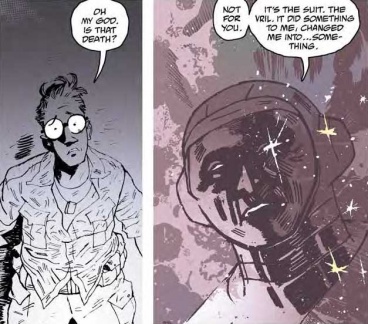
And the same could be true of Gall Dennar’s sword. When its first owner, the Hyperborean warrior, died, it is possible that his spirit lingers in some form, attached to the sword. This certainly seems to be the case, for when Gall Dennar’s grandfather took up the blade, he felt the spirit of the Hyperborean warrior in his arm. When this happened, he was able to fend off a horde of undead creatures. Perhaps this spirit is a factor in what makes Gall Dennar and Howards so impervious.
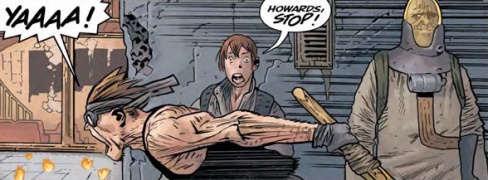
As far as I know, the Hyperborean warrior was the weapon’s first owner, then Gall Dennar’s grandfather, then Gall Haddat, then Gall Dennar himself, and then after that… I don’t know. The sword could have stayed in his family for many generations and had many owners for thousands of years. But eventually it came to rest in the ruins of a Hyperborean city, either Urrasan or Hypos (I’m not sure which), in a place that would later be known as the Sahara desert. At some point primitive humans lived in these Hyperborean ruins. Perhaps they were Gall Dennar’s ancestors, or perhaps even Gall Dennar himself went there. There were passages in those ruins that led into the hollow of the Earth, which theoretically could connect to any other Hyperborean cities. Vast oceans are no obstacle when one can travel below them, and we’ve already seen in B.P.R.D.: Hollow Earth and B.P.R.D. King of Fear how extraordinary distances have been travelled. Could Gall Dennar or his ancestors have made an intercontinental journey to Africa via the Hollow Earth at some point?

What is rather curious here is that Sir Edward took up the sword, but he did not suddenly find himself in prehistoric times in someone else’s body. Some unknown set of circumstances had not been met.
Later the sword was taken by the Heliopic Brotherhood of Ra and the sword ended up with the Knights of the Silver Star, an offshoot of the original brotherhood, in a secret chamber in Chicago, the very same chamber Agent Howards would later discover. And as we’ve already discussed, he touched the blade and some kind of connection was forged between him and Gall Dennar, so that they know live their lives in parallel, separated by a vast abyss of time.

I don’t know. But as you can see, I have a few crazy theories.
Continued belowSHONCHIN
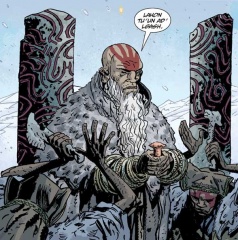
This guy has been kicking around for a long time now. He was first named in Born Again, John Arcudi’s debut B.P.R.D. story. Although only eight pages, this story put some rather significant pieces into play, though you wouldn’t know it at the time. In the story, the B.P.R.D. was called into Caulfield, a suburb of Chicago (that place again…), which was being haunted by some kind of monstrous ghost. At a construction site, they found the bones of a creature that appeared to be dinosaur-like, but were nowhere near as old.

Using Johann Kraus’s ectoplasm as a medium, they were able to speak to the creature, and it was able to speak back. Its spirit had clung to its bones, waiting for Shonchin so that it might have revenge for its death. And then it kind of went insane with rage and so Liz destroyed it with her fire (Vril energy again). Afterwards they concluded that Shonchin could have been a North American aboriginal shaman. While exploring the site, Roger the homunculus even found an implement that had once belonged to Shonchin, though he didn’t know it, set in stone with markings made around it.

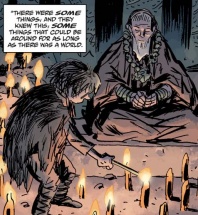

In the later years of his life, Shonchin came across a man, apparently a victim of the Ogdru cult, but the shaman could see what he was truly. He had been possessed by an Ogdru spirit, and when it realised it had been discovered, it transformed itself from human to a hideous creature. Shonchin easily killed it with a blast of Vril energy. And later, the bones of this creature would be found in a construction site in Caulfield.

But what happened to Shonchin after this? As I said, the implement he required to channel Vril was found at this site by the B.P.R.D., so did he die shortly afterwards? The implement certainly wasn’t just discarded. It was placed into part of the rock with designs drawn around it. Perhaps leaving the item behind in this manner was what kept the spirit contained to its bones for so long.
Continued belowIt has been said that the human students of the Hyperborean priests were of lesser faith than their teachers. They feared what Vril energy could do in at the hands of the unenlightened, so they never took students of their own, and their secrets died with them.
Except for Shonchin. Somehow he found a way to reach beyond his lifetime.

In B.P.R.D.: The Black Flame Liz Sherman used Shonchin’s implement to magnify her existing powers and destroy Katha-Hem. Shortly before this, she saw a vision of Shonchin holding the implement, reciting words. She mimicked his words and his grasp on the device, and by doing so she was able to use it. Keep in mind, prior to this Liz had spent several years in a monastery called Agartha in the Ural Mountains studying under monks that claimed to be directly descended from the first humans, the ones that had contact with the pre-human Hyperboreans. In her stay at Agartha she had advanced significantly in her control of her Vril power. So this wasn’t a case of Shonchin teaching a total novice, he was teaching an already advanced student, one that had already spent the better part of her life trying to master the Vril energy bound to her very soul.
Shonchin had found a way to take a student he deemed worthy many thousands of years after his own death.

But how did this connection happen in the first place? Did Liz unknowingly develop it in her time in Agartha from the monks that likely descended from Shonchin’s kin? Or was there something darker at work? Liz was guided to the implement by Memnan Saa, who was a major villain throughout the Plague of Frogs cycle.5 Memnan Saa had spent his own time in a monastery with the Chutt warriors, a people that claimed to be the spiritual children of the Hyperboreans, specifically the Hyperboreans that followed the way of the Left Hand.

That Left Hand thing is kind of significant too because Shonchin bears the mark of a left hand upon his forehead, a mark given to him by a Hyperborean priest, almost certainly a follower of the Left Hand.
This doesn’t necessarily mark him as an evil man, after all, we know so little about those Hyperboreans that remained for millennia to watch over humanity during its infant years, but what we know so far about them should make us at least a little wary. That said, the Right Hand/Left Hand thing is probably a great deal more nuanced than a good/bad dichotomy. Shonchin’s teacher had taught him to fight Ogdru spirits after all.
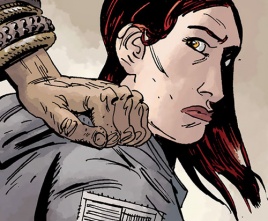
But how? Is he reaching across time, in a connection similar, yet different from the one Gall Dennar and Ted Howards share? Or maybe his spirit is entangled with Liz’s. I’ve already said Vril has allowed spirits to attach themselves to suits of armour and to a sword… Is it also possible then that Shonchin’s spirit had become entangled with the implement he used to channel Vril all his life? When Liz used it, is that how their connection was established?
Continued below
But Liz doesn’t really need an implement to use Vril. The source of Vril energy comes from herself. It is bound to her soul. So perhaps when she used Shonchin’s implement, his spirit which had previously been tied to the device, became tied to her instead, tethering himself to the living Vril in his student.
And make no mistake, Liz is Shonchin’s student. The new heights of her power, and the precision with which she can wield it, have all been learned under Shonchin’s guidance. And I don’t think he’s done with her yet. We have seen, very briefly, that Liz has a third eye in her forehead. It opened while she was under the power of Memnan Saa and allowed her to break free. Perhaps there will come a time when Liz can open this eye at will, and then… well, who know’s what she could do?

OTHER SHAMANS
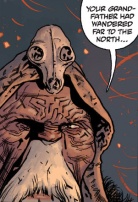

One thing I would like to point out though, is that Shonchin is most definitely American. At one point he lived in the area that is now Chicago. And when he was a young boy, he came across the ruins of a Hyperborean city from the latter Hyperborean Empire. This is significant because there were only seven of these: Hypos and Urrasan (one or both of which are in the Sahara), Thadrethes (in the Stanovoy Range between China and the U.S.S.R.), Atlantis (somewhere in the North Atlantic Ocean), Lemuria, possibly another called Urr (though this could be a variant name for Urrasan), and one more… I’ve no idea what it’s called though. So if Shonchin lived his life on the continent of North America, then the ruins of the city he found are likewise on the continent, and perhaps it was even the same city visited by Gall Dennar’s grandfather where he found the Hyperborean blade.

Because the one in North America may have been found.

So what’s with this girl? I’ve no idea yet.
And there’s some other shamans I’d like to discuss too. It has been established that the mythologies of the Mayans and the Aztecs and other peoples of the Americas have some truth in them. In Abe Sapien: The Shape of Things to Come, Abe learned that some of their legendary god monsters were in fact Ogdru Hem (such as Vucub Caquix and Cipactlhem), and some of their heroes were the shamans that fought them (such as the Mayan twins, Hunahpu and Xbalanque).

Abe even learned that there were descendants of these people still alive, and some of their ways survived, in particular the ability to shape shift. This is something we’ve seen before in B.P.R.D.: The Black Goddess. The Chutt warriors were able to shape shift after all.
And Gall Dennar is living in a time when these legends may have been unfolding. Hell, he could very well meet twin brothers that fight an Ogdru spirit some day.
So, where does that leave us? Frankly, with a lot of questions. And I really do mean a lot. The prehistoric era of Gall Dennar and Shonchin is vast and what we’ve seen so far is only the tip of the iceberg. It seems to me more than half of this column has been me asking questions. There is so much more yet to discover…
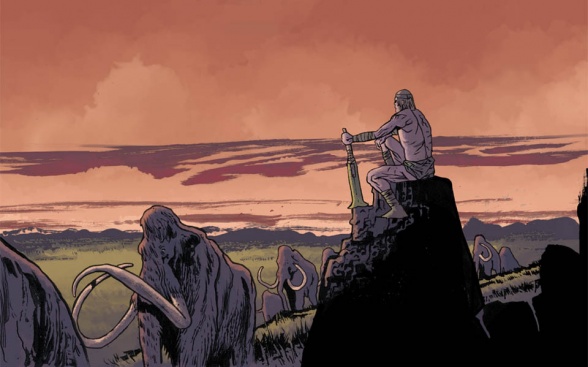
And that’s it! The last Hell Notes of the year. If there was ever a post to pitch your crazy theories, this is it, so throw them into the comments. There’s a pretty good chance you may have caught something I missed. Are there any other connections here? I’m sure further issues of Flesh and Stone will prove enlightening…
And finally, here’s my notes on my notes.
1The Chicago Temple: This was a temple of the Knights of the Silver Star, a secret society that had its origins in the Heliopic Brotherhood of Ra. It was also the location where the famous paranormal investigator Sir Edward Grey left the earthly plane and was dragged down into Hell on the 3rd of March, 1916. See Hellboy in Hell #4.
2Hellboy’s encounter with Dr. Carp: The full story can be found in Hellboy: Dr. Carp’s Experiment.
3The Cold People: There are many indications, though nothing concrete, that the cold people were an early variety of vampire.
4Black Heccatta: Hecate, Heca-Emem-Ra, the Black Goddess. She has many names, and I’ve written about her before.
5Memnan Saa: My claim that Memnan Saa is a villain is a gross over-simplification. Certainly there were villainous aspects about him, but in his own way he was trying to serve the greater good of humankind. Make of him what you will.
6The Watcher, Anum: I suppose you could call this guy an angel. He was one of the greater spirits that guided Earth’s creation. However, he dared to take the Fire of Heaven from the sky in his right hand, and from it fashioned the Ogdru Jahad. It was by the power in his right hand that the Odgru Jahad were sealed away, and it is only by the power of his right hand that they can be unleashed again.
7The madness of Professor J.H. O’Donnell: Professor O’Donnell gained both madness and insight in September, 1987, when he visited the home of the deceased necromancer, Alessandro Divizia. What happened precisely is really open to interpretation. See B.P.R.D. Hell on Earth: The Transformation of J.H. O’Donnell.






